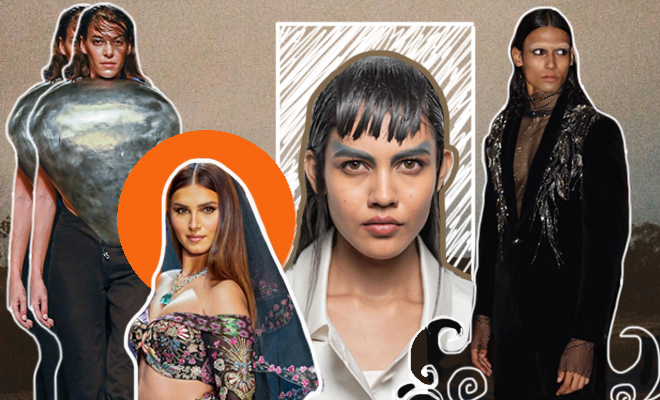Remember when Cassie in Euphoria said, “if that makes me a villain, then so f*cking be it. I can play the villain,” in her onstage speech amidst Lexi’s much-talked-about play? Yep, that’s exactly the villain era, that we are going to be discussing. A time when women set their boundaries, and decide to finally do what they believe in. TikTok’s bubble around the villain era is all about turning your anger into art. Coming back home is the 70s-famous punk rock, leather, edgy black, and short glazed bob. This era aims at using fashion as a means of expression, something that this category was always meant to be. And embracing every aspect, and stitch of this aesthetic are designers, parading on runways.
This past month, India’s best-known couturiers, and style curators, described their take on the villain era, with gender-neutral silhouettes, expressive cuts, black in abundance, and edgier-than-ever designs. At the recently departed FDCI X Lakmé Fashion Week, I sat down to watch boredom leave the chat for badass construction to walk the ramp. The mood boards were filled with flavours of dark cabaret, and potential punk, Bollywood’s obsession with spooky jhoomers turned into chandelier chic (remember, “issi jhoomer ke neeche milegi Shanti Priya ki laash”), and avant-garde. For even the most culturally-rooted designer creations, a spicy mix of black showed colour-related stereotypes the way to exit. From designer Aisha Rao’s showstopper–Tara Sutaria, dressed as a bride in black, to designer Akshat Bansal’s Bloni twirling in outer space, with a gamut of futuristic fabrics, and construction, the runway reminded us to set ourselves free.
The villain era, as embraced by India’s finest troop of designers, exchanged soft-girl pastels for only, and only black. Charcoal cravats coupled with printed sarees, and models emoting their angst as a part of the showcase, presentations paid homage to freedom to draw boundaries, pushed us to speak our minds, and scrap-off toxic behaviour. In a bid to nurture this sudden awareness of self, and bash stereotypes, motif-driven, bold embroideries replaced delicate sequins. Fabrics too expressed a sense of drama, and structure, as light-weight chiffon, and georgettes, took the back seat and pushed cord work ahead.
Alternating with tangerine dresses, and still-breathing traces of fruity colours, were designer collections by Gaurav Gupta, and Amit Aggarwal, and the homecoming of master couturier Shahab Durazi. In sets of several concept sarees and dizzy sequin masks, designers displayed their love for anti-heroes. This glamorous marriage between E-girl, and dark academia, was also a visible affair through hard-hitting background music, and spacecore inspired set design. Taking a backseat were also traditional, and society-approved reds for festive dressing. This brand new idea of sarvgun sampan, was a refreshing perspective put on India’s love-hate relationship with a certain section of colours, neckline lengths, and veils. For the latter half, longer trails came chopped off, for an edgier spin to a classic bridal veil. Blouses also loaned inspiration from sultry bustiers, and corsets, to serve the modern-day brides. This indeed raised some eyebrows, but only for the good.
Closing this version of the villain era, as described by the fashion week, was designer Rajesh Pratap Singh’s final presentation. Putting an end to the five-day-long fashion fest, was Pratap’s ode to opera chic. Frowned faces, furious eyes, sharp hair bangs, and black-polished ghunghroos, romanced with the dark. Coupled with this surprising addition of accessories, were clown, and combat boots, crafted shoulders, gelled-up hair, silk-tissue garments, and exaggerated brows.
In a bid to channel the villain, or the most unfiltered self in you, designers offered genderfluid fashion, multi-media maximalism, and print galore. Some others gave culturally-appropriate drapes, a westernised twist, through dhoti pants, heeled boots, and lips dipped in deeper hues. Revaluating the wedding guest dress code were a few designers, who expressed a liking towards unconventional shapes, sassy eye makeup, and concept skirts. Designer collection by Satya Paul, promised a new way to embrace oneself, which was through escapism.
Also Read: Barbiecore, Coastal Grandmother, E Girl: Find Your Style Vibe From Our List Of Fashion Aesthetics
Clinging to this wide variety of imagination, amidst an uncertain world, was the designer’s association with technicolour garments, three-dimensional prints, and dreamy activewear, sported by talents from all walks of life. This new form of diversification, helped garments find a match in shoppers, by selling a distinct identity, making even the runways a home to TikTok’s love for villain era.
Well, it is time to push people pleasing away, and set yourself free. Are you in your villain era?
Feature Image Credits: Jasveen Kaur Sawhney
